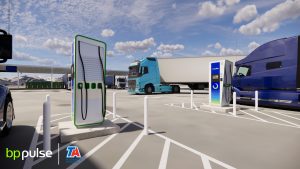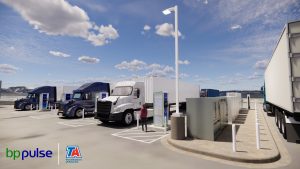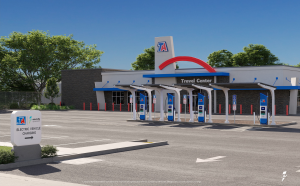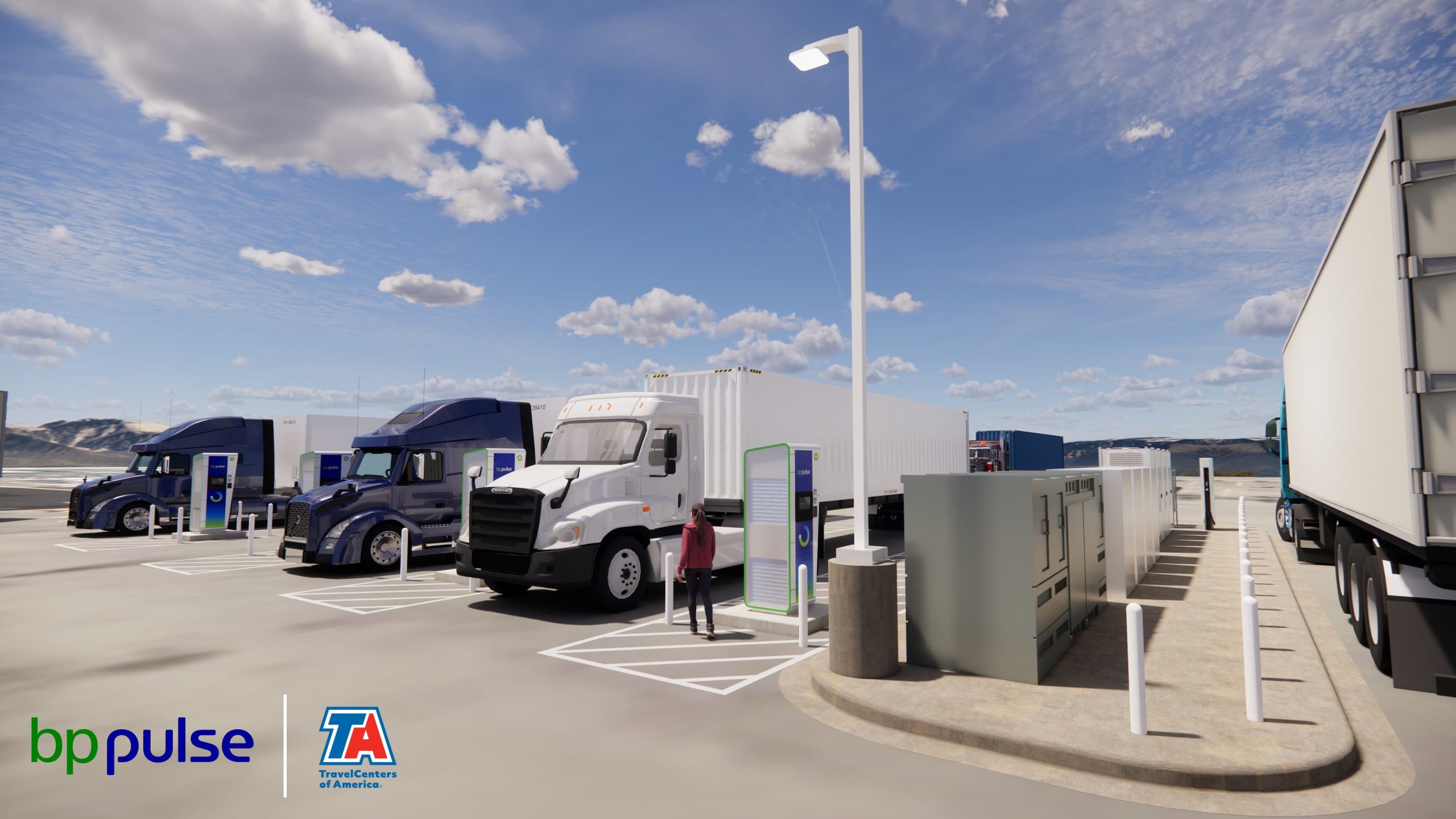- Discover how TA truck charging stations are leading the future of heavy-duty EV infrastructure with the first public-access site in California.
- Learn about BP’s $1 billion strategy to deploy 100,000 ultra-fast EV chargers worldwide, starting with a game-changing site for electric trucks.
- Explore the innovative technologies, from megawatt chargers to solar-powered microgrids, revolutionizing electric truck charging infrastructure.

TA is paving the way with one of the first public-access heavy-duty truck charging stations in California.
TravelCenters of America (TA) has recently broken ground on its first TA truck charging stations for medium and heavy-duty electric vehicles, marking a significant milestone in the expansion of EV infrastructure in the United States. Located in Ontario, California, this site is set to become one of the first publicly accessible charging stations specifically designed for heavy-duty trucks. For more news and updates on Electric Trucks, check out this page.
TA Truck Charging Stations: A New Era in Heavy-Duty EV Charging
TravelCenters of America (TA) is making significant strides in the EV charging infrastructure landscape, particularly in supporting the electrification of medium- and heavy-duty trucks. The TA truck charging stations project is not just about adding more chargers—it’s pioneering the development of a public-access EV charging network tailored to meet the specific demands of heavy-duty trucks.
This initiative begins with the recently announced station in Ontario, California, which is set to be one of the first publicly accessible EV charging sites for large trucks in the U.S. Located strategically at the intersection of two of the country’s busiest interstate highways, this site serves as a crucial hub for early-adopter electric truck fleet operators, demonstrating the importance of building electric truck charging infrastructure. To dive deeper into the developments around Charging Stations, follow this link.
BP’s $1 Billion EV Charging Strategy

With four 400-kilowatt chargers and a 1-megawatt option, the Ontario station leads in heavy-duty EV charging.
Enjoying our insights?
Subscribe to our newsletter to keep up with the latest industry trends and developments.
Stay InformedThe Ontario truck charging station is part of a broader strategy by BP, which acquired TA in 2023 as part of its transition toward becoming an integrated energy company. This acquisition allowed BP to tap into TA’s expansive network of highway sites, providing an opportunity to seamlessly introduce charging solutions for fleet operators across North America. Explore the challenges and strategies in Fleet Management for electric vehicles, explore this page.
BP has committed $1 billion to build a global network of EV charging stations, with the goal of reaching 100,000 chargers by 2030. To accelerate this goal, BP made a $100 million investment in ultra-fast chargers from Tesla, intended for use at various locations within its convenience store and travel center network, including TA truck charging stations.
Details of the Ontario, California Charging Site
The Ontario, California location will feature four 400-kilowatt chargers expected to be operational by early 2025, alongside a 1-megawatt charger, which will become available in 2026. These chargers are designed to support up to five trucks simultaneously, providing DC ultra-fast charging and demonstrating the feasibility of public-access charging for battery-electric heavy-duty trucks. Additionally, this site will integrate a microgrid powered by 250 kilowatts of canopy-mounted solar panels and a battery energy storage system capable of storing up to 1 megawatt-hour of energy. Stay updated on the latest trends in Heavy-Duty Trucks, click here.
The microgrid’s renewable energy component not only boosts the station’s sustainability but also ensures that power is consistently available, even in case of grid instability. This innovative system, combined with the megawatt charger, will make the site one of the most advanced public-access truck charging stations in the nation. Learn more about how Infrastructure advancements are shaping the future of transportation, visit this link.
This project is part of a larger effort supported by the California Energy Commission, in alignment with California’s zero-emission vehicle (ZEV) goals. The CEC actively supports public-access charging infrastructure through its funding and strategic partnerships, ensuring that projects like TA’s heavy-duty EV stations help advance California’s clean transportation initiatives.
What This Means for Fleet Operators

The new truck charging station integrates renewable energy through a solar-powered microgrid.
Fleet operators, especially those managing early-adopter electric truck fleets, will greatly benefit from this development. Heavy-duty electric trucks typically require much more robust charging infrastructure than passenger vehicles, and the ultra-fast chargers at TA’s Ontario site are designed to meet this need. These chargers will minimize downtime for electric trucks, enabling fleet operators to maintain efficient schedules while supporting the broader transition to sustainable transportation solutions. For insights on the role of Sustainability in the trucking industry, check out this page.
According to Sujay Sharma, CEO of bp pulse Americas, this project marks just the beginning of BP’s efforts to support the trucking industry with fast and reliable EV charging infrastructure. With electric truck sales on the rise, the demand for public-access charging stations that can handle the unique needs of heavy-duty vehicles is critical. By taking the lead in this area, TA and BP are positioning themselves as key players in the electrification of the freight industry. Stay abreast of the latest developments regarding BP and their initiatives, explore this link.
TA’s Vision for Sustainable Transportation

BP’s $1 billion investment aims to build 100,000 ultra-fast EV chargers globally by 2030.
Debi Boffa, CEO of TA, emphasized the importance of this project for the company’s future. “We are proud to take a leading role in bringing this infrastructure to our fleet customers and other professional drivers,” she said. This statement reflects TA’s ambition to be at the forefront of sustainable transportation solutions.
The company has been planning EV charging infrastructure expansion for several years. Back in 2021, designs for the Ontario truck charging station began in collaboration with the California Energy Commission and the Electric Power Research Institute. This station is a pilot project, with TA and BP looking to expand their charging network to additional locations in Southern California and other U.S. corridors.
Expanding to Other Southern California Locations
BP and TA are actively exploring new locations for similar projects in Southern California, with plans to expand their heavy-duty EV charging stations nationwide. These future sites will likely incorporate similar advanced features, including ultra-fast chargers, microgrids, and battery energy storage systems, further solidifying the EV charging network.
Expanding this infrastructure along key transportation corridors will make it easier for fleet operators to transition to electric trucks. This aligns with broader efforts to decarbonize the transportation sector, reduce emissions, and meet growing regulatory requirements for zero-emission vehicles.
Technical Specifications of the Chargers
- 400-kilowatt Chargers: Capable of delivering ultra-fast charging for medium- and heavy-duty trucks, significantly reducing charging times compared to standard chargers.
- 1-megawatt Charger: Designed for the next generation of heavy-duty electric trucks, this powerful charger will allow for even faster charging and extended range for large commercial fleets.
- Microgrid & Renewable Energy: An integrated microgrid powered by 250-kilowatt solar panels will ensure a reliable, renewable energy source for the site. The battery energy storage system, capable of holding up to 1 megawatt-hour of energy, will further enhance the site’s resilience and efficiency.

TA and BP’s collaboration is set to expand to additional locations in Southern California and beyond
These technical innovations will make the Ontario site a showcase for what the future of heavy-duty EV charging can look like.
Innovation in Public-Access Charging for Trucks
The Ontario site’s role as an innovation hub will help BP and TA test new technologies, paving the way for the future of public-access charging for battery-electric trucks. This pilot project will inform the development of future megawatt chargers and demonstrate the effectiveness of charging heavy-duty electric trucks in a public setting.
By building the infrastructure needed to support heavy-duty electric vehicles, TA and BP are addressing one of the major hurdles in the widespread adoption of electric trucks. This project, combined with BP’s overarching strategy to build a global network of EV chargers, underscores both companies’ commitment to sustainable transportation and the electrification of the freight industry.
The completion of this project and others like it will play a pivotal role in shaping the future of electric mobility for heavy-duty transportation in the U.S., providing the fast, reliable charging infrastructure necessary for fleet operators to adopt electric trucks at scale.
Key Insights into TA’s Heavy-Duty EV Charging Stations
- Strategic Charging Location in Ontario, California
TA’s first public-access heavy-duty truck charging station is strategically located at the intersection of two major interstate highways, making it ideal for supporting early-adopter electric truck fleets. - Ultra-Fast and Megawatt Charging Technology
The station will feature 400-kilowatt chargers ready by 2025 and a 1-megawatt charger by 2026, offering one of the first large-scale, ultra-fast charging solutions for heavy-duty electric vehicles. - Sustainability-Driven Design
The site includes a solar-powered microgrid and a battery energy storage system capable of providing up to 1 megawatt-hour of renewable energy, ensuring stable power even during grid interruptions. - BP’s $1 Billion EV Charging Expansion
TA’s charging stations are part of BP’s global $1 billion investment in EV infrastructure, aiming to install 100,000 chargers globally by 2030, with a focus on fleet and truck operators. - Nationwide Expansion Plans
BP and TA plan to expand this model to other Southern California locations and additional corridors across the U.S., establishing a robust charging network for commercial fleets transitioning to electric trucks.
- Strategic Charging Location in Ontario, California
Explore External Resources for EV Infrastructure and Heavy-Duty Truck Charging
- California Energy Commission provides in-depth information on the state’s efforts to expand EV infrastructure. Read about California’s strategic goals for zero-emission vehicles and its need for 1.2 million chargers by 2030. Learn more here.
- BP Pulse Fleet Solutions offers information on their global EV charging strategy, including infrastructure developments for medium and heavy-duty trucks. Explore the details here.
- Assembly Bill 2127 EV Infrastructure Assessment outlines California’s plans for the future of charging infrastructure to support zero-emission vehicles. Delve into the specifics here.





















